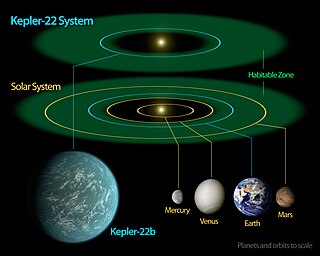
An exomoon or extrasolar moon is a natural satellite that orbits an exoplanet or other non-stellar extrasolar body.

Kepler-22b is an exoplanet orbiting within the habitable zone of the Sun-like star Kepler-22. It is located about 640 light-years from Earth in the constellation of Cygnus. It was discovered by NASA's Kepler Space Telescope in December 2011 and was the first known transiting planet to orbit within the habitable zone of a Sun-like star, where liquid water could exist on the planet's surface. Kepler-22 is too dim to be seen with the naked eye.

Kepler-69 is a G-type main-sequence star similar to the Sun in the constellation Cygnus, located about 2,430 ly (750 pc) from Earth. On April 18, 2013 it was announced that the star has two planets. Although initial estimates indicated that the terrestrial planet Kepler-69c might be within the star's habitable zone, further analysis showed that the planet very likely is interior to the habitable zone and is far more analogous to Venus than to Earth and thus completely inhospitable.
Kepler-88 is a Sun-like star in the constellation of Lyra, with three confirmed planets. In April 2012, scientists discovered that a Kepler candidate known as KOI-142.01 (Kepler-88b) exhibited very significant transit-timing variations caused by a non-transiting planet. Timing variations were large enough to cause changes to transit durations to Kepler-88b as well. Large transit-timing variations helped to put tight constraints to masses of both planets. The non-transiting planet was further confirmed through the radial velocity method in November 2013.

Kepler-90g is a super-puff exoplanet orbiting the early G-type main sequence star Kepler-90, one of eight planets around this star discovered using NASA's Kepler space telescope. It is located about 2,840 light-years (870 pc) from Earth, in the constellation Draco. The exoplanet was found by using the transit method, in which the dimming effect that a planet causes as it crosses in front of its star is measured. It orbits its parent star about every 210.5 days at a distance of 0.71 astronomical units.

Kepler-138, also known as KOI-314, is a red dwarf located in the constellation Lyra, 219 light years from Earth. It is located within the field of vision of the Kepler spacecraft, the satellite that NASA's Kepler Mission used to detect planets transiting their stars.

Kepler-438b is a confirmed near-Earth-sized exoplanet. It is likely rocky. It orbits on the inner edge of the habitable zone of a red dwarf, Kepler-438, about 472.9 light-years from Earth in the constellation Lyra. It receives 1.4 times our solar flux. The planet was discovered by NASA's Kepler spacecraft using the transit method, in which the dimming effect that a planet causes as it crosses in front of its star is measured. NASA announced the confirmation of the exoplanet on 6 January 2015.
Kepler-438 is a red dwarf in the constellation Lyra, about 640 light years from Earth. It is notable for its planetary system, which includes Kepler-438b, a possibly Earth-size planet within Kepler-438's habitable zone.
Kepler-419c is a super-Jupiter exoplanet orbiting within the habitable zone of the star Kepler-419, the outermost of two such planets discovered by NASA's Kepler spacecraft. It is located about 3,400 light-years from Earth in the constellation Cygnus. The exoplanet was found by using the transit timing variation method, in which the variations of transit data from an exoplanet are studied to reveal a more distant companion.
Kepler-419 is an F-type main-sequence star located about 3,400 light years from Earth in the constellation Cygnus. It is located within the field of vision of the Kepler spacecraft, the satellite that NASA's Kepler Mission used to detect planets that may be transiting their stars. In 2012, a potential planetary companion in a very eccentric orbit was detected around this star, but its planetary nature was not confirmed until 12 June 2014, when it was named Kepler-419b. A second planet was announced orbiting further out from the star in the same paper, named Kepler-419c.
Kepler-1625 is a 14th-magnitude solar-mass star located in the constellation of Cygnus approximately 8,000 light years away. Its mass is within 5% of that of the Sun, but its radius is approximately 70% larger reflecting its more evolved state. A candidate gas giant exoplanet was detected by the Kepler Mission around the star in 2015, which was later validated as a likely real planet to >99% confidence in 2016. In 2018, the Hunt for Exomoons with Kepler project reported that this exoplanet has evidence for a Neptune-sized exomoon around it, based on observations from NASA’s Kepler Mission. Subsequent observations by the larger Hubble Space Telescope provided compounding evidence for a Neptune-sized satellite, with an on-going debate about the reality of this exomoon candidate.
Kepler-1625b is a super-Jupiter exoplanet orbiting the Sun-like star Kepler-1625 about 2,500 parsecs away. The large gas giant is approximately the same radius as Jupiter and orbits its star every 287.4 days. In 2017, hints of a Neptune-sized exomoon in orbit of the planet was found using photometric observations collected by the Kepler Mission. Further evidence for a Neptunian moon was found the following year using the Hubble Space Telescope, where two independent lines of evidence constrained the mass and radius to be Neptune-like. The mass-signature has been independently recovered by two other teams. However, the radius-signature was independently recovered by one of the teams but not the other. The original discovery team later showed that this latter study appears affected by systematic error sources that may influence their findings.

Kepler-1625b I, a possible moon of exoplanet Kepler-1625b, may be the first exomoon ever discovered, and was first indicated after preliminary observations by the Kepler Space Telescope. A more thorough observing campaign by the Hubble Space Telescope took place in October 2017, ultimately leading to a discovery paper published in Science Advances in early October 2018. Studies related to the discovery of this moon suggest that the host exoplanet is up to several Jupiter masses in size, and the moon is thought to be approximately the mass of Neptune. Like several moons in the Solar System, the large exomoon would theoretically be able to host its own moon, called a subsatellite, in a stable orbit, although no evidence for such a subsatellite has been found.








